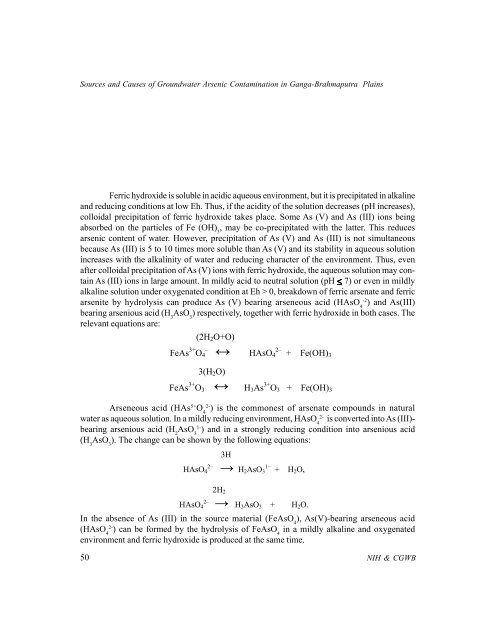Mitigation and Remedy of Groundwater Arsenic Menace in India
Mitigation and Remedy of Groundwater Arsenic Menace in India
Mitigation and Remedy of Groundwater Arsenic Menace in India
You also want an ePaper? Increase the reach of your titles
YUMPU automatically turns print PDFs into web optimized ePapers that Google loves.
Sources <strong>and</strong> Causes <strong>of</strong> <strong>Groundwater</strong> <strong>Arsenic</strong> Contam<strong>in</strong>ation <strong>in</strong> Ganga-Brahmaputra Pla<strong>in</strong>sFerric hydroxide is soluble <strong>in</strong> acidic aqueous environment, but it is precipitated <strong>in</strong> alkal<strong>in</strong>e<strong>and</strong> reduc<strong>in</strong>g conditions at low Eh. Thus, if the acidity <strong>of</strong> the solution decreases (pH <strong>in</strong>creases),colloidal precipitation <strong>of</strong> ferric hydroxide takes place. Some As (V) <strong>and</strong> As (III) ions be<strong>in</strong>gabsorbed on the particles <strong>of</strong> Fe (OH) 3, may be co-precipitated with the latter. This reducesarsenic content <strong>of</strong> water. However, precipitation <strong>of</strong> As (V) <strong>and</strong> As (III) is not simultaneousbecause As (III) is 5 to 10 times more soluble than As (V) <strong>and</strong> its stability <strong>in</strong> aqueous solution<strong>in</strong>creases with the alkal<strong>in</strong>ity <strong>of</strong> water <strong>and</strong> reduc<strong>in</strong>g character <strong>of</strong> the environment. Thus, evenafter colloidal precipitation <strong>of</strong> As (V) ions with ferric hydroxide, the aqueous solution may conta<strong>in</strong>As (III) ions <strong>in</strong> large amount. In mildly acid to neutral solution (pH < 7) or even <strong>in</strong> mildlyalkal<strong>in</strong>e solution under oxygenated condition at Eh > 0, breakdown <strong>of</strong> ferric arsenate <strong>and</strong> ferric-2arsenite by hydrolysis can produce As (V) bear<strong>in</strong>g arseneous acid (HAsO 4) <strong>and</strong> As(III)bear<strong>in</strong>g arsenious acid (H 3AsO 3) respectively, together with ferric hydroxide <strong>in</strong> both cases. Therelevant equations are:(2H 2 O+O)FeAs 3+ – 2–O 4 ↔ HAsO 4 + Fe(OH) 33(H 2 O)FeAs 3+ O 3 ↔ H 3 As 3+ O 3 + Fe(OH) 3Arseneous acid (HAs 5+ O 42-) is the commonest <strong>of</strong> arsenate compounds <strong>in</strong> naturalwater as aqueous solution. In a mildly reduc<strong>in</strong>g environment, HAsO 42-is converted <strong>in</strong>to As (III)-bear<strong>in</strong>g arsenious acid (H 2AsO 31-) <strong>and</strong> <strong>in</strong> a strongly reduc<strong>in</strong>g condition <strong>in</strong>to arsenious acid(H 3AsO 3). The change can be shown by the follow<strong>in</strong>g equations:3H2–HAsO 41–→ H 2 AsO 3 + H 2 O,2H 22–HAsO 4 → H 3 AsO 3 + H 2 O.In the absence <strong>of</strong> As (III) <strong>in</strong> the source material (FeAsO 4), As(V)-bear<strong>in</strong>g arseneous acid(HAsO 42-) can be formed by the hydrolysis <strong>of</strong> FeAsO 4<strong>in</strong> a mildly alkal<strong>in</strong>e <strong>and</strong> oxygenatedenvironment <strong>and</strong> ferric hydroxide is produced at the same time.50NIH & CGWB




